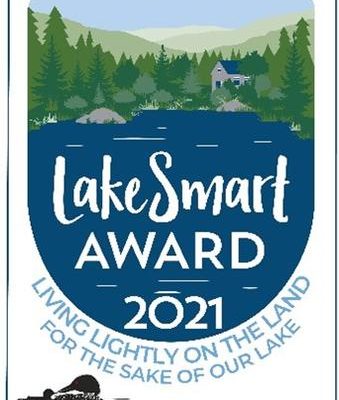by Bill Dexter • MPA Board Member
Last year was a banner year for LakeSmart property evaluations. 2024 was less busy, but we were asked to consult with a couple of families building on the shores of Moose Pond. They want their landscaping to be as lake friendly as possible. We’re looking forward to doing a formal evaluation of their properties in the near future!
LakeSmart is a statewide program designed to help landowners minimize their impact on lakes, ponds, and rivers. It’s a simple, straightforward, NO cost, NO penalty way to learn how to accomplish this. Just contact me (my contact details appear at the end of this article) and we’ll have you fill out a form and will set up a time to visit your property. From there, a member of the Moose Pond LakeSmart team (Peter LaPolice, Elizabeth Stockwood, or me) will come by to evaluate your property. If you meet a prescribed standard, you achieve “LakeSmart status” and get a couple of great looking plaques to post on your property. Many recipients place one near their mailbox and the other down near their dock. If you don’t achieve LakeSmart status after your first inspection, we can prescribe a number of simple, low-cost fixes to get you there.
LakeSmart is primarily focused on issues related to runoff and erosion; it’s the number one cause of pollution in our lakes. What are the most common issues we identify? What are some of the most common fixes?

The most common issue is water running down the bank in an uncontrolled and unfiltered manner straight into the lake. This is typically a result of uncontrolled runoff from roads, driveways, and roofs, as well as a lack of duff and/or vegetation between the source of the water and the lake. Duff is accumulated leaves, pine needles, etc., which acts like a big sponge to soak up water. There are some really easy and inexpensive ways to deal with runoff.
- Build a surface berm. This can be dirt, erosion control mulch (ECM), rock, etc.
- Reduce runoff from roofs with a well-constructed gravel drip line or gutters (I know, I know, who wants gutters!)
- Install a “razor” bar (typically a 2×6 foot or 2×8 foot board with a rubber “razor” on top). These work particularly well for driveways that are seasonal (as winter plowing will rip them up).
- Make sure that paths to your waterfront are no more than six feet wide, and are well defined and winding. It doesn’t take long for your lot/waterfront to get packed down by “wandering feet!”
- Let duff accumulate.
- Plant native plantings (blueberry bushes are awesome and…you get blueberries!)
- Where there are any bare areas – as it may take some time to allow duff to accumulate or plants to establish – consider using ECM. It’s inexpensive and works great!
Help us keep Moose Pond the pristine lake we all love!
Just a reminder that Maine has strict shoreline zoning regulations, and the Legislature has recently passed LD2101. This allows towns to assess fines and put liens on any properties violating shoreline ordinances. So, if you’re considering making any changes to your lot/waterfront, it’s best to contact your local Code Enforcement Officer to make sure your plans are in compliance. The Moose Pond LakeSmart team is always available to discuss your property and/or landscaping plans. It’s important to highlight that LakeSmart DOES NOT report our evaluation findings to any agency – only to the property owner.
If you have any questions, I would enjoy hearing from you. Either I, or another member of the Moose Pond LakeSmart team, would love to come by and do a LakeSmart evaluation for you. Help us keep Moose Pond the pristine lake we all love!
Bill Dexter • dexathome@gmail.com • cell 207-232-0726

